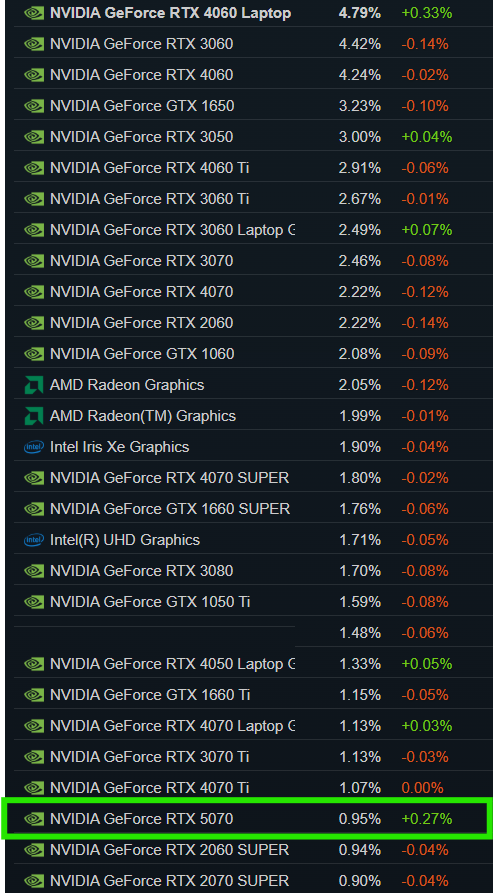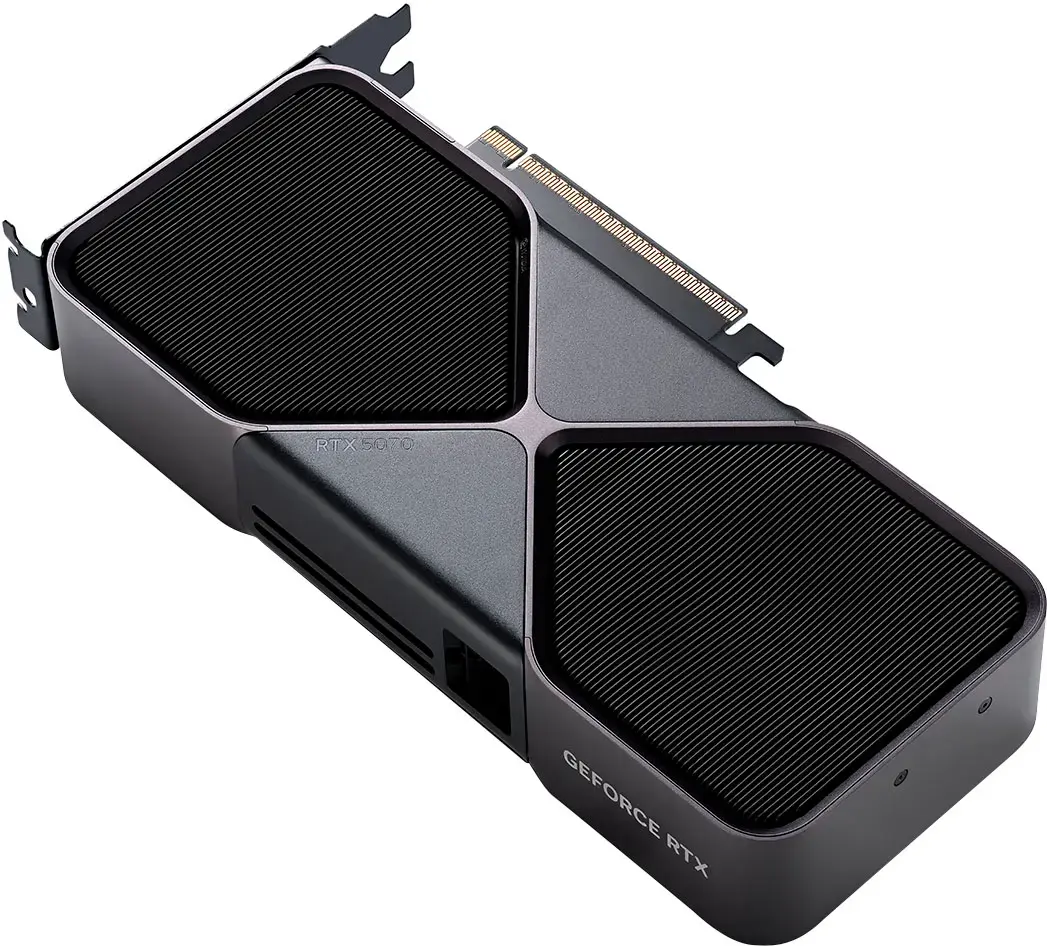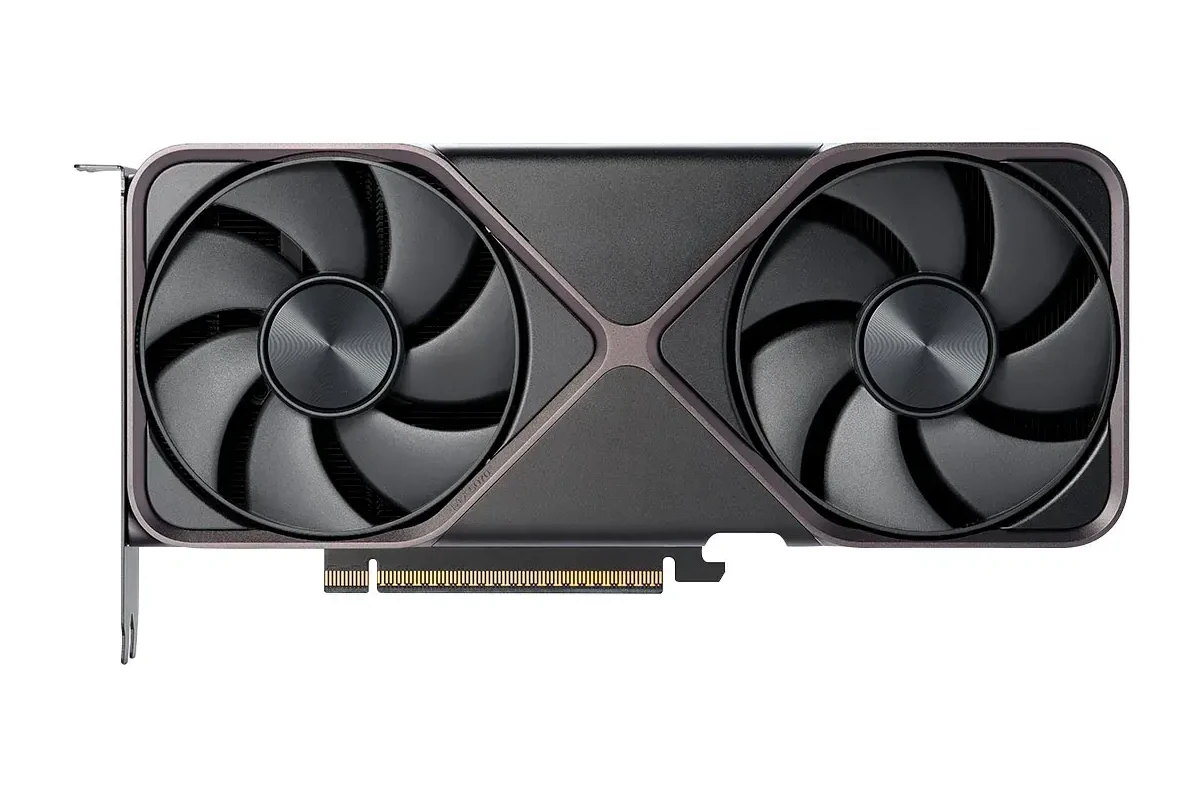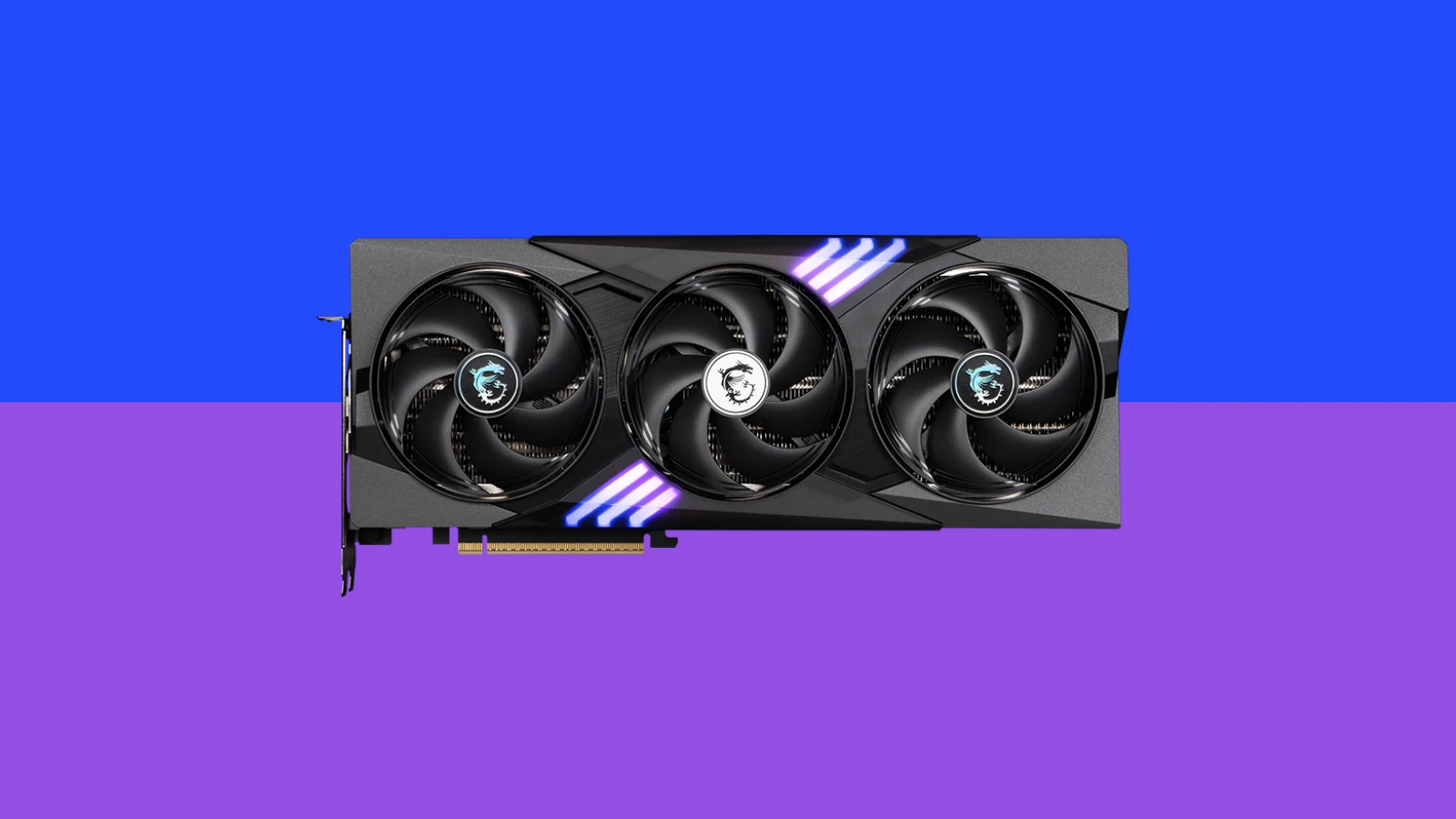The numbers are in, and NVIDIA’s GeForce RTX 5070 has officially emerged as the most widely adopted next-generation graphics card on Steam. According to Valve’s June 2025 Hardware & Software Survey, the RTX 5070 now powers 0.99% of all gaming PCs on the platform—putting it ahead of other newly released Blackwell-based RTX 50-series GPUs, including the more expensive RTX 5080 and RTX 5090.
This marks a major milestone for NVIDIA’s latest architecture and highlights a key trend: gamers are gravitating toward high-performance GPUs that balance power, pricing, and availability. And in that equation, the RTX 5070 is striking gold.

The Sweet Spot in the 50-Series Lineup
Launched earlier this spring, the RTX 5070 sits squarely in NVIDIA’s upper-midrange category. Built on the Blackwell architecture, it features next-gen RT and tensor cores, supports DLSS 4.0, and includes enhanced frame generation tech—all while using less power than its Lovelace predecessor. The result is a card that delivers 4K-ready performance at a price point that’s more accessible than the 5080 or 5090.
Its rapid rise in Steam’s monthly hardware charts shows that PC gamers are responding to that value. The 5070 has quietly leapfrogged the 5080 (0.55%) and 5070 Ti (0.53%) and is nearly doubling the adoption of the 5090 (0.18%)—a flagship card still limited by cost and niche demand.

What’s Driving Adoption?
Several factors have propelled the RTX 5070’s popularity:
- Mainstream pricing: Positioned below the $699 mark in most markets, the 5070 undercuts the enthusiast-tier 5080/5090 GPUs while still delivering ray-traced gaming at high resolutions.
- Wider availability: Unlike the initial launch wave of RTX 40-series cards, which suffered from supply bottlenecks, the 5070 has seen a more stable retail rollout. Major OEMs have also begun shipping prebuilt systems with 5070s as the default GPU option for upper-tier gaming rigs.
- Performance-per-watt improvements: The 5070 has garnered praise from reviewers for its efficiency gains over the RTX 4070 Ti and 3070, making it a desirable upgrade for users with modest power supplies or compact builds.
A Growing Footprint for RTX 50 Series
The 5070’s success is part of a larger story: the RTX 50-series now accounts for 3.69% of all GPUs tracked on Steam, and that share is growing quickly. While lower-end Blackwell cards like the RTX 5060 and 5060 Ti are just beginning to appear in the rankings, the 5070 is clearly leading the charge, signaling that gamers are willing to invest in next-gen capabilities if the price-performance ratio is right.

In contrast, AMD’s RDNA 4 cards are still noticeably absent from the charts, and Intel’s Battlemage lineup has yet to make an appearance, highlighting NVIDIA’s dominant position in this generation’s early race.
The Shift in the GPU Landscape
With more games leaning into technologies like ray tracing, AI upscaling, and DirectStorage, having a capable GPU is no longer just about raw power—it’s about feature support. The RTX 5070 checks every box: it’s ready for the future of PC gaming without asking for an enthusiast’s budget.
Titles like Cyberpunk 2077 2.1, Alan Wake II, and Hellblade II now come optimized for DLSS 4 and Blackwell acceleration, putting the 5070 in a prime spot for delivering consistently high frame rates with cutting-edge visuals.
Looking Ahead
With the RTX 5070 gaining ground rapidly and NVIDIA showing no signs of slowing its rollout, expect to see more mainstream and lower-end Blackwell GPUs climb the charts in the months ahead. If the trend continues, the 5070 may soon surpass older heavyweights like the RTX 3060 and 4060 in market share.
For gamers building a system in mid-2025, the message from Steam’s data is clear: the RTX 5070 is the next-gen card that’s actually within reach—and it’s becoming the go-to choice for serious PC players who want futureproof performance without overspending.
RX 7800 XT vs RTX 4070
The battle between AMD’s RX 7800 XT and NVIDIA’s RTX 4070 continues to be a hot topic among gamers and tech enthusiasts. Each graphics card brings unique strengths to the table, making the choice between them more complex than just looking at price tags. The RX 7800 XT offers superior rasterization performance and 16GB of VRAM, outperforming the RTX 4070 by up to 28% at 1440p resolution according to recent benchmarks.
When comparing these two powerful GPUs, it’s important to consider more than just raw performance. The RTX 4070 counters with better ray tracing capabilities, approximately 14% better performance in RT workloads, and exclusive access to DLSS 3.0 technology. NVIDIA also generally receives praise for more reliable driver support, which can be crucial for consistent gaming experiences across different titles.
Here’s a comparison table between the AMD Radeon RX 7800 XT and the NVIDIA GeForce RTX 4070:
| Feature/Specification | AMD Radeon RX 7800 XT | NVIDIA GeForce RTX 4070 |
| Architecture | RDNA 3 | Ada Lovelace |
| Process | 5nm | 4nm |
| Memory | 16GB GDDR6 | 12GB GDDR6X |
| Memory Bus | 256-bit | 192-bit |
| Memory Bandwidth | 620 GB/s | 504 GB/s |
| TGP (Typical Power Draw) | 250-280W | 200-230W |
| Recommended PSU | 750W | 650W |
| 1440p Gaming (Rasterization) | Often slightly better or competitive | Very strong, competitive with RX 7800 XT |
| Ray Tracing Performance | Good, but generally lags behind RTX 4070 | Significantly better due to more mature RT core tech |
| Upscaling Technology | FSR 3.0 (FidelityFX Super Resolution) | DLSS 3.0 (Deep Learning Super Sampling) |
| AI/Productivity Features | Strong in OpenCL rendering; good for DaVinci Resolve | Superior for CUDA-based applications (e.g., Blender, AI/ML), faster video rendering (Adobe Premiere Pro) |
| Price (approximate) | $499 – $549 | $549 – $599 |
Key Considerations:
- Gaming Performance (Rasterization): The RX 7800 XT often holds a slight edge in traditional rasterization performance, particularly at 1440p.
- Ray Tracing & Upscaling: The RTX 4070 excels in ray tracing and has a more mature and generally preferred upscaling technology (DLSS, especially with Frame Generation).
- VRAM: The RX 7800 XT offers 16GB of VRAM, which provides more headroom for future games and higher texture settings compared to the RTX 4070’s 12GB. This can be a significant factor for longevity and memory-intensive titles.
- Power Efficiency: The RTX 4070 is more power-efficient, drawing less power and requiring a lower recommended PSU.
- Price: The RX 7800 XT generally comes at a lower price point, offering strong value for its raw performance.
- Ecosystem/Features: NVIDIA offers robust software like GeForce Experience, CUDA support for professional applications, and Broadcast Tools. AMD provides Radeon Software and features like Smart Access Memory (SAM).
Ultimately, the better choice depends on your priorities. If raw rasterization performance and a larger VRAM buffer are your main concerns, and you’re budget-conscious, the RX 7800 XT is a strong contender. If ray tracing, superior upscaling technology, and better power efficiency are more important, the RTX 4070 might be the way to go.
Key Takeaways
- The RX 7800 XT delivers better raw performance and more VRAM, while the RTX 4070 excels in ray tracing and offers DLSS 3.0 technology.
- Performance differences vary by resolution, with the 7800 XT showing its greatest advantage (up to 28%) at 1440p gaming.
- Your choice should depend on specific gaming needs, with consideration for VRAM requirements, ray tracing importance, and software feature preferences.
Comparative Overview of Radeon RX 7800 XT and RTX 4070
When comparing AMD’s Radeon RX 7800 XT and NVIDIA’s RTX 4070, we see two distinctly different approaches to mid-range graphics solutions. Both cards target similar performance segments but achieve their results through different technical implementations and feature sets.
Architecture and Chip Design
The RX 7800 XT is built on AMD’s RDNA 3 architecture using a chiplet design based on the Navi 32 GPU. This approach separates the graphics processing components across multiple smaller dies manufactured on a 5nm process. The design helps AMD improve manufacturing yields while delivering strong performance.
In contrast, NVIDIA’s RTX 4070 uses the monolithic Ada Lovelace architecture. This single-chip design is also built on an advanced process node but takes a more traditional approach to GPU design. The RTX 4070’s architecture particularly excels in specialized workloads like ray tracing.
Both cards represent significant advances over their previous generations, with improved efficiency and performance per watt. The architectural differences impact not just raw performance but also feature implementation and driver support.
Performance Metrics
In pure rasterization performance (traditional rendering), the RX 7800 XT generally holds a slight edge, offering approximately 3% better performance according to TechPowerUp reviews. This advantage is most noticeable in games that don’t heavily utilize ray tracing.
However, the RTX 4070 demonstrates superior ray tracing capabilities, performing approximately 14% better in RT workloads. This makes NVIDIA’s offering more future-proof for games incorporating advanced lighting techniques.
The 4070 also benefits from DLSS 3.0 with Frame Generation technology, which can significantly boost frame rates in supported titles. While AMD has introduced FSR 3 with similar functionality, NVIDIA’s implementation is currently more mature and widely supported.
Game compatibility and driver stability also favor the RTX 4070, with fewer reported issues across a broader range of titles.
Memory and Bandwidth
The RX 7800 XT features 16GB of GDDR6 memory on a wider 256-bit bus. This provides both more capacity and greater memory bandwidth compared to the RTX 4070’s configuration.
NVIDIA’s RTX 4070 comes with 12GB of GDDR6X memory on a narrower 192-bit bus. While the memory capacity is lower, the GDDR6X technology offers higher speeds that partially offset the narrower bus width.
The memory advantage of the 7800 XT becomes particularly important in memory-intensive applications and games running at high resolutions with texture-heavy environments. For 4K gaming or applications that require handling large data sets, the additional 4GB on the AMD card provides a tangible benefit.
These memory differences might impact future performance as games continue to increase their memory requirements over the coming years.
Innovative Technologies and Gaming Experience
Both AMD’s 7800 XT and NVIDIA’s 4070 bring cutting-edge features that enhance gameplay. Their technologies shape the overall gaming experience, with each offering unique advantages for different types of gamers.
AI and Ray Tracing Capabilities
The RTX 4070 shines with its dedicated ray tracing hardware, offering about 18% better ray tracing performance than the 7800 XT. This advantage becomes apparent in games with heavy lighting effects and reflections. NVIDIA’s card also features specialized Tensor cores that power DLSS 3 with Frame Generation, a technology that can significantly boost framerates in supported titles.
AMD’s 7800 XT counters with stronger rasterization performance—about 7% better in traditional rendering. This gives it an edge in games that don’t heavily use ray tracing. For 1440p gaming, both cards deliver excellent framerates, but the 7800 XT often pulls ahead in pure raster performance.
The 4070’s AI capabilities extend beyond gaming, making it versatile for content creators who use AI-accelerated applications.
Supporting Technologies and Standards
The 7800 XT offers more forward-looking connectivity with DisplayPort 2.1 support, while the 4070 uses the older DisplayPort 1.4 standard. AMD’s card also features a larger 16GB VRAM buffer compared to the 4070’s 12GB, potentially beneficial for future games with higher memory demands.
For upscaling technology, NVIDIA provides DLSS which offers superior image quality, while AMD counters with FSR 2.0 and the newer FSR 3 with frame generation. The 7800 XT utilizes Infinity Cache and Smart Access Memory to optimize performance when paired with AMD processors.
Both cards fully support modern APIs including DirectX 12 Ultimate, Vulkan, and OpenGL. The 4070 offers better AV1 encoding capabilities, useful for streamers and content creators looking for efficient video compression.
Frequently Asked Questions
The RX 7800 XT and RTX 4070 offer different strengths depending on your gaming needs. These cards compete closely in performance but differ in ray tracing capabilities, memory configurations, and value propositions.
How does the gaming performance of the Radeon RX 7800 XT compare to the RTX 4070?
In traditional raster performance, the RX 7800 XT has a slight edge over the RTX 4070, offering about 3% better performance in most games. This advantage is noticeable in titles that don’t heavily rely on ray tracing effects.
However, when ray tracing is enabled, the RTX 4070 pulls ahead with approximately 14% better performance. This makes the NVIDIA card more suitable for gamers who prioritize visual fidelity with ray-traced lighting and shadows.
The performance difference between these cards is relatively minor in most gaming scenarios, making both viable options for 1440p gaming.
What are the main technical differences between the RX 7800 XT and the RTX 4070?
Memory configuration is a key difference, with the RX 7800 XT offering 16GB of VRAM compared to the RTX 4070’s 12GB. This larger memory buffer may benefit games with high-resolution textures and future titles.
The RTX 4070 features NVIDIA’s DLSS 3.0 technology, which includes frame generation capabilities not present in AMD’s FSR 3. This can provide significant performance boosts in supported games.
Architecture differences also impact performance, with NVIDIA’s Ada Lovelace architecture excelling in ray tracing while AMD’s RDNA 3 architecture offers strong traditional rendering capabilities.
Which graphics card offers better value for money: the RX 7800 XT or the RTX 4070?
The RX 7800 XT typically offers better value in terms of raw performance per dollar for traditional gaming. It provides similar or slightly better rasterization performance at a generally lower price point.
The RTX 4070’s value proposition strengthens for users who will utilize DLSS 3.0 and ray tracing features. These technologies can significantly enhance both performance and visual quality in supported titles.
Price fluctuations in the GPU market mean that the better value option may change depending on current promotions and availability.
Can you provide an analysis of the RX 7800 XT versus RTX 4070 benchmarks?
Benchmark results show that the RX 7800 XT and RTX 4070 are neck-and-neck in most gaming scenarios without ray tracing. In some titles, the 7800 XT pulls slightly ahead due to its additional VRAM and rasterization capabilities.
When ray tracing is enabled, benchmark data consistently shows the RTX 4070 taking the lead. The difference becomes more pronounced in games with intensive ray-traced effects.
DLSS and FSR upscaling technologies affect benchmark results significantly. The RTX 4070’s DLSS 3.0 with frame generation provides a substantial performance boost that AMD’s FSR 3 currently cannot fully match.
What improvements does the RTX 4070 Super offer over the RX 7800 XT?
The RTX 4070 Super enhances the gap in ray tracing performance compared to the RX 7800 XT. It delivers even stronger performance in games that utilize ray-traced lighting, reflections, and shadows.
DLSS 3.0 frame generation remains exclusive to the RTX series, giving the 4070 Super a significant advantage in supported titles. This technology can boost framerates substantially without a noticeable loss in image quality.
The 4070 Super also offers improved rasterization performance that helps close or eliminate the slight advantage the RX 7800 XT had over the original 4070 in traditional rendering.
In terms of future-proofing, which GPU is a better investment, the RX 7800 XT or the RTX 4070?
The RX 7800 XT’s 16GB of VRAM provides better future-proofing for memory-intensive applications and games. As texture sizes and game assets continue to grow, this larger memory buffer may extend the card’s useful lifespan.
NVIDIA’s more mature ray tracing technology and DLSS ecosystem give the RTX 4070 an edge as these technologies become more widespread in games. Developer support for NVIDIA’s features is currently more robust.
Driver support longevity varies between manufacturers. Both AMD and NVIDIA typically provide driver updates for several years, but historical patterns suggest NVIDIA may maintain support for slightly longer periods.







